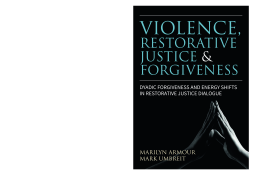
Additional Information
Book Details
Abstract
A groundbreaking book founded on extensive original research, designed to determine how restorative dialogue works, and the role of forgiveness within it.
The research involved interviews with 20 victims who went through a Victim Offender Dialogue (used in crimes of severe violence), and documents how the shifts in energy during the course of their dialogue moves the toxicity associated with the crime to a different place. This study explores the role of bilateral forgiveness in restorative work and addresses key questions about the role of forgiveness in restorative justice, such as how it can be measured. It also outlines a model which explains how the energy flow of dyadic forgiveness in restorative justice dialogue is formed.
Rich in data and in findings, this book will deepen understanding of how restorative justice works, and will inform future research and practice in the field.
An important new theoretical model based on the best of qualitative research-a deep dive into 20 restorative justice dialogues to explain how these encounters created profound psychological transformation for victims of terrible violence.
David R. Karp, PhD, Professor of Sociology, Skidmore College
Armour and Umbreit make a giant leap in the restorative justice discussion. Fascinating reading, and this is a truly new way of speaking about and thinking about the Victim Offender Meditation/Dialogue. This is well worth the read!
Everett L. Worthington, Jr., Author of Forgiveness and Spirituality in Psychotherapy: A Relational Approach (with Steven J. Sandage; APA Books)
Marilyn Armour is a University Distinguished Teaching Professor and founding Director of the Institute for Restorative Justice and Restorative Dialogue, in the School of Social Work at the University of Texas at Austin.
Dr. Mark Umbreit is a Professor and the founding Director of the Center for Restorative Justice & Peacemaking at the University of Minnesota School of Social Work.
Table of Contents
| Section Title | Page | Action | Price |
|---|---|---|---|
| Acknowledgements | 5 | ||
| Preface | 11 | ||
| 1. Dyadic Forgiveness in Restorative Justice - A Review of the Field and a Proposed Model | 15 | ||
| Purpose | 15 | ||
| Introduction | 15 | ||
| Types of forgiveness | 18 | ||
| Restorative justice and moral rectification | 22 | ||
| The energy of forgiveness | 23 | ||
| Energy shifts | 25 | ||
| Methodology for archival review | 26 | ||
| Glossary of constructs | 26 | ||
| Energy flow dynamics in restorative justice dialogue | 37 | ||
| Conclusion | 40 | ||
| References | 41 | ||
| 2. Victim Case Narratives and Analysis | 45 | ||
| Introduction | 45 | ||
| 3. Mapping Dyadic Forgiveness - An Analysis of Positive Energy Shifts in Restorative Justice Dialogue | 235 | ||
| 1. Crime and Its Impact | 237 | ||
| Emotional turbulence | 239 | ||
| Emotional disconnection | 241 | ||
| Blocked energy | 242 | ||
| 2. Motivation and Preparation | 244 | ||
| 2. Motivation and Preparation - Efforts to Resolve Negatively Charged Energy | 244 | ||
| Efforts at self-change | 244 | ||
| Energy shifts | 247 | ||
| VOD motivation | 248 | ||
| Preparation | 254 | ||
| Impact of preparation on openness and hesitancy | 258 | ||
| Openness continuum | 260 | ||
| 3. Dyadic dialogue | 263 | ||
| Dyadic encounter | 263 | ||
| Dyadic engagement | 265 | ||
| Pain transformation | 272 | ||
| Dyadic forgiveness | 274 | ||
| Energy shifts | 286 | ||
| 4. Resolution and Post‑Dialogue Outcomes | 292 | ||
| Resolution | 292 | ||
| Post-dialogue outcomes | 297 | ||
| 5. Dyadic forgiveness | 303 | ||
| Introduction | 303 | ||
| Mutual aid: Giving and receiving | 304 | ||
| Shifts in energy | 305 | ||
| Movement in negatively to positively charged energy | 306 | ||
| Role of dissonance in energy movement | 308 | ||
| Accountability in dyadic forgiveness | 309 | ||
| Dyadic forgiveness and meaning-making | 310 | ||
| Dyadic forgiveness and levels of engagement | 311 | ||
| Dyadic forgiveness and the sense of injustice | 312 | ||
| The project’s limitations | 313 | ||
| Implications of the project | 313 | ||
| Conclusion | 314 | ||
| References | 315 | ||
| Appendix | 317 | ||
| 1. Study methodology | 319 | ||
| Introduction | 319 | ||
| Methodology | 320 | ||
| ReferenceS | 324 | ||
| 2. Paradox of forgiveness - Reflection sheet | 325 | ||
| 3. Paradox of forgiveness - Interview guide | 327 | ||
| 4. Paradox of forgiveness - Demographic and background survey | 329 | ||
| Subject Index | 331 | ||
| Author Index | 335 | ||
| Blank Page |
